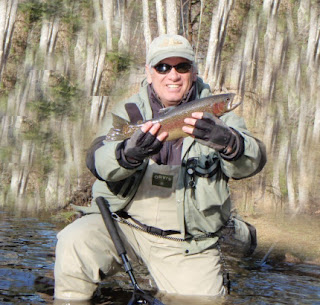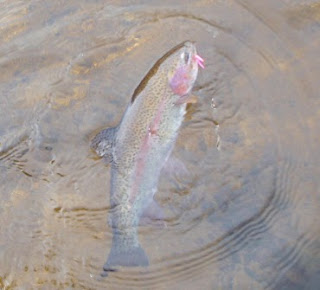I was out fishing one of my local rivers last week. While presenting every style of dry fly I owned to some very reluctant fish a large spent Dobsonfly fell from an overhanging tree. I know the river to be filled with hellgrammites and understanding this life cycle became an important task. The huge floating bug didn't last five feet before it was consumed by a good sized rainbow.
In the river bed we will find the larva stage of this big bug. Clinging to the underside of rocks and feeding on other smaller larva of caddis, mayfly and midges, for up to five years. They can go through a molting of exoskeleton up to twelve times as they outgrow their skin.

Reaching a pupal stage is the time they crawl from the river and can walk up to 50 feet from the bank. They will find a moist location under rocks for another week or two.
Metamorphosis
takes place and the courtship begins. Males fight for the rights to females.
Another two weeks and the females will lay eggs clinging to leaves above the river or on rocks along the bank where the hatching larva falls into the water in search of it's residence. They like the faster oxygenated riffles that will provide a food supply.
A key factor to their entire life cycle is the darkness of night. During the summer when their time to leave the stream starts the thunderstorms vibrations trigger their walking journey.
So, now that I learned a bit about these large four wing adults the tying began. First was on a #8 4x long streamer hook and was too small. Next a #4 5x and that seemed to be the right size. Off to the river I went with three hours to learn what I could.
I tied on the 5x and made my first cast to a visible bow. The fly landed three feet above in a slow current and the fish took the fly. No hook up. Ten more times I had fish take the fly with the same result. No hook up. The only fish that fit the entire bug in it's mouth all at once was a three pound smallmouth bass.
What I realized was the trout were grabbing the fly by the wings and needed to chomp in order to take it in their mouth completely. One bite and they knew it was a fake and spit it out. The other problem was keeping the fly floating. Back to the bench.

Softer foam wings, foam under body and a smaller hook placed up at the head with a hollow tube as the body extension. I sealed the back of the tube with UV epoxy.
Again, I went back to the river. Crazy how many fish continued to be attracted to the fly. The floating issue is totally solved. Fish were making takes and still not getting hooked. Then it hit me. The leader was slightly dragging the fly so it was pointing toward me. So, I changed my position to only be casting down and across stream giving me the ability to control the fly pointing up stream and still be dead drifting. When the 18" Rainbow took the fly and then turned the hook was in position. Next ties will have a slightly larger hook.
Now that I know I have a real working fly it is time to give it a name. It will be called
'Rodan'




 The bows are moving nicely right now. I am amazed at the range of flies that these lake run fish will take. This one hit a hot pink San Juan Micro worm. Never my go to fly but one that was shared on the river. We were also successful with Orange Eggs, Caddis Pupa, Hendrickson, Olive Leech and Pheasant Tails.
The bows are moving nicely right now. I am amazed at the range of flies that these lake run fish will take. This one hit a hot pink San Juan Micro worm. Never my go to fly but one that was shared on the river. We were also successful with Orange Eggs, Caddis Pupa, Hendrickson, Olive Leech and Pheasant Tails.  The key to this style of fishing is, with out a doubt, a slow and natural flow presentation. None of my fish hit a swinging fly even though I was fishing a streamer or leech as my top fly. What this tells me is that the water is still cold and the metabolism of the trout low. Always be aware of the distance between your indicator and the first weight. Many anglers are using a weighted fly as the way to get down. As no two pools are the same depth and speed you must always adjust.
The key to this style of fishing is, with out a doubt, a slow and natural flow presentation. None of my fish hit a swinging fly even though I was fishing a streamer or leech as my top fly. What this tells me is that the water is still cold and the metabolism of the trout low. Always be aware of the distance between your indicator and the first weight. Many anglers are using a weighted fly as the way to get down. As no two pools are the same depth and speed you must always adjust.